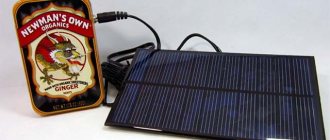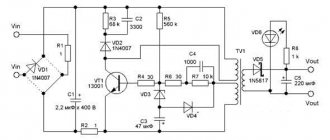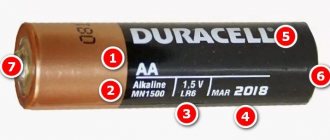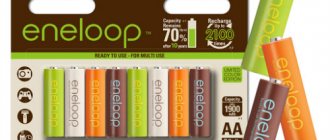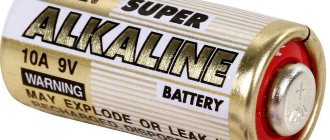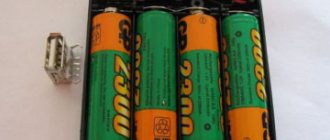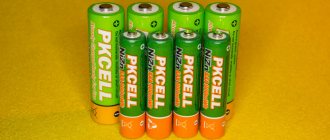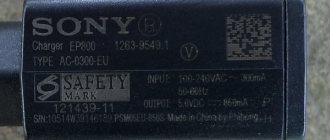The term “battery” from an electrical engineering book is a source of electric current in which several electrochemical elements are connected. As a result of the chemical process occurring in the “body”, electricity is generated. In everyday life, batteries are anything that provides direct current, that is, capable of powering or charging an electronic device. Power supplies are not rechargeable, so they do not last forever. Let's look at the design of the battery, on what principle it works and what types it comes in.
A battery works by converting chemical energy into electrical energy.
Principle of operation
Arriving at the store, hundreds of different power sources are found on the shelves. They differ in technical characteristics, but they are united by the principle of operation. Each battery has plus and minus poles and an electrolyte in the form of a liquid or dry substance - these are the main elements. Electricity moves from “+” to “-”.
Cathodes, designated as “minus”, work as reducing agents - energy comes to them from the anode. During the chemical reaction, ions are formed, which move inside the battery in a special medium - an electrolyte. During the life of the power source, other substances are formed in it, and the electrodes are deformed - it shrinks.
This is the principle of operation of a classic battery. The processes occurring in it are irreversible. This means that the power source cannot be recharged.
What does it consist of?
The battery consists of a cardboard, plastic or metal casing. In portable voltage sources, the outer shell, as a rule, does not participate in the electrochemical reaction.
Inside the battery there is a positive rod and electrolyte, which also takes part in the transmission of electric current. The design of the battery may be different, but almost all types of current sources have the listed parts.
If necessary, you can get such elements by carefully disassembling the battery and removing the contents from its case for study.
Types of batteries
There are several main types, the difference between which is in the materials used for production and components such as electrolyte, anode and cathode.
Types of batteries:
- saline. Material – passive carbon and manganese dioxide, electrolyte – ammonium, cathode – zinc. When the power source does not “work”, it is restored - it evens out the inhomogeneities of the electrolyte, which extends its service life. They are inexpensive, but are characterized by low capacity;
- alkaline (alkaline). Unlike salt power sources, here the electrolyte is alkaline. Such batteries are especially popular among manufacturers of electronic devices. They last a long time, the voltage on their electrodes practically does not change, but the price is more expensive than salt ones;
- lithium A common option today is where the cathode consists of lithium and an organic electrolyte is used. Advantages of lithium batteries: wide operating temperature range, high energy density, can be stored for a long time. The only drawback is the high price;
- mercury. Anode – zinc, cathode – mercury oxide. Between the substances there is a separator and a diaphragm impregnated with an electrolyte - potassium hydroxide. Such a power source can work like a battery, but the capacity will decrease over time. Advantages: stable voltage, capacity and energy density. Cons: price and mercury in the composition - a toxic substance;
- silver The electrolyte is potassium or sodium hydroxide. The properties of the battery are similar to mercury, but are non-toxic and last longer.
Composition is not the only classifier. Power supplies also differ in shape, size, etc.
Where does the current come from?
Unlike batteries, a battery is made in such a way that it cannot be recharged. However, this current source has the necessary current at its contacts to power various devices. The physics of this phenomenon is very simple:
- The metal element is placed in an oxidizer, into which positively charged particles pass.
- In this case, negative ions will accumulate in the metal.
When a consumer is connected, this mechanism will be maintained until the metal is almost completely consumed.
Features of the device of different types of batteries
Its design features depend on the size and shape of the product. Let's look at the types of batteries available.
Cylindrical
They have an elongated body and, as a rule, a metal shell that hides the internal parts. Immediately behind the “insulation” there is a layer of conductive metal (in salt power supplies this is zinc). It connects to the minus.
In the center of the battery body there is a graphite rod - the positive terminal. During operation, a protective cap is placed on one side to protect it from damage. An electrolyte and a depolarization mixture are placed between the rod and the negative sheath.
Cylindrical batteries.
For convenience, the following are marked:
- A23 – mini-pinky;
- AA – finger;
- AAA - little finger ones.
Voltage parameter – up to 6 V.
Square
Brick-shaped batteries that produce up to 9 V voltage, but are used quite rarely. They are also called "crown".
More expensive than its younger brothers, more massive. There are salt and alkaline models. Feature - the case contains 6 compact power supplies of 1.5 V each. Each individual product works in the same way as a AA or other battery.
The body material is usually metal, in rare cases durable plastic. The “+” and “-” terminals are located on one of the flat sides, made of dielectric.
When choosing such a battery, you need to look at the dimensions, since the same models, but from different manufacturers, may differ by 1 - 2 mm. The reason is the different thickness of the shell, which protects against damage.
Square batteries.
There are batteries with the inscription “Rechargeable” on the case. This means that the battery can be charged by connecting it to a special charger.
Disk
These power supplies are also called “tablets” or “discs”. They themselves are small, and are used in compact instruments and devices - wristwatches, table scales, flashlights, etc. The voltage of disk batteries does not exceed 3 V.
The assortment is wide, and when choosing a replacement, you need to start from the device for which it is taken. At a minimum, take into account the dimensions of the installation location.
Application
Different types can be used in different ways, depending on their basic design properties and characteristics:
- Batteries with solid electrolyte are used in devices with low current consumption. For example, low power clock flashlights, as well as remote controls.
- Alkaline batteries are used in electrical engineering with a high current value, these include various cameras and tape recorders, as well as toys with an electric motor.
- Power supplies with silver electrodes can provide electricity to calculators, portable instruments and hearing aids.
- Lithium batteries are used in portable electronics where stable capacity and current consumption are required.
Phone battery device
Smartphone battery device.
The battery, that is, the battery of a smartphone, is an element that accumulates the energy reserve necessary for the operation of the gadget for hours.
Many cell phones contain lithium-ion (Li-ion) batteries, which consist of two key parts: a pair of electrodes and an electrolyte. Electrodes are made from different materials - lithium, graphite, etc., and they all involve working with lithium as a base.
Lithium is a reactive metal, meaning it reacts with other elements. In its pure form, it is so active that it ignites in air, so smartphone batteries use a safer version - lithium cobalt oxide.
Between the two electrodes is an electrolyte, usually a liquid substance that allows current to pass through. When the battery is charged, lithium cobalt oxide molecules trap electrons and release them when the phone is used.
Li-ion batteries are the most common because they hold a large charge despite their compact size. And to “restore” them, just connect a smartphone charger.
Classification
There are many sizes, classifications and markings of current sources. It is difficult for an inexperienced person to understand them. Another difficulty lies in the fact that there are several classifications in the world, and in our market you can find different manufacturers - the USA, Europe, China, domestic companies.
Batteries differ in shape. This is perhaps the very first thing that catches your eye. There are:
- Cylindrical (LR03, LR6, LR14, LR20). These are finger, little finger devices, the so-called barrels. They look like a regular cylinder. Their length is greater than their width. The diameter may vary.
- Disc (LR44, L1154). Batteries of this type are popularly called “button” or “hour” batteries. They are flattened and look like a disk or a tablet. Sizes may vary.
The letter classification originated in the USA; it is widely used throughout the post-Soviet countries. Let's imagine the difference between letters and sizes in the table:
| Type | Name | Height, mm | Diameter, mm |
| AAA | Mini-finger, little finger | 44,5 | 10,5 |
| AA | Finger | 50,5 | 14,5 |
| WITH | Average hourly | 50 | 26,5 |
| D | Big sentry | 61,5 | 34,2 |
| 1604D | Crown | 67 | 26 by 22 |
Dimensions vary by several millimeters. This is due to the fact that the manufacturer can enclose the battery in a special shell. It protects against moisture or makes the battery shock-resistant. If the battery is alkaline, the letter “L” will be written on the packaging.
Approximate chemical composition of all batteries
The most common elements are: nickel, cadmium, lead, lithium, mercury, zinc, manganese, iron, aluminum. Substances can be combined, but all are never used at the same time.
Batteries are power sources used to operate a variety of devices. When choosing a replacement, you need to take into account the parameters of the consumer device. There are many varieties, each with its own characteristics. Manufacturers are introducing new technologies to make batteries safer for both humans and the environment.
Backlash
All types of batteries and cells have a similar type of chemical reaction that occurs to generate electricity.
But in some types of cells or batteries, the chemicals are different and the reaction may be reversed. In this way, the cells can be recharged - just like lithium-ion batteries in cars or smartphones.
It used to be much cheaper to produce non-rechargeable cells such as alkaline cells, so they were used very widely.
But now that people have realized how bad it is for the environment to simply throw away non-rechargeable cells, and as rechargeable cells become cheaper, we'll likely use non-rechargeable cells less and less in the future.
Where are alkaline batteries used?
In everyday life, a person is surrounded by many household appliances, and since batteries are produced with different capacities, this parameter is worth paying attention to. After all, the larger the capacity, the stronger the voltage produced by the battery, and the longer it works.
Alkaline batteries can be found in:
- kitchen and floor scales;
- remote control panels;
- wall and floor clocks;
- children's toys;
- medical devices (tonometers, thermometers);
- medical equipment devices (hearing aids, wheelchairs, sensors);
- radios, portable speakers and many other devices.
Which factories assemble batteries?
There are five factories in Russia that assemble batteries:
- "Space". He began his activities back in 1933. Its structure includes more than 35 production facilities located throughout Russia and in some other countries, for example, there are several factories in China. Every year the factory produces more than one hundred million current sources. During its existence, the manufacturer has proven itself from the best side, which is confirmed by numerous awards.
- "Photon". Despite the fact that the company appeared only in 2011, it has managed to take a leading position in the battery production sector. This is due to the high quality of the products. Numerous tests have confirmed the long service life of the batteries. At the same time, they cost much less than their imported counterparts.
- "Liotech". The plant is considered a joint brainchild of Russian and Chinese corporations. Its facilities assemble and produce lithium-ion power sources used for the production of batteries.
- "Energy". The enterprise, located in the city of Yelets, works closely with the Ministry of Defense. This confirms the reliability of the manufacturer and the high quality of the products. In 2011, the line was modernized and a conveyor for assembling lithium-ion power supplies was launched. The main part of the products are “finger” and “little finger” batteries.
- "SSK". The factory began producing batteries in 1993. Mostly fourth and fifth generation batteries come off the assembly line. In addition, the plant is continuously working to increase the battery capacity, and is also studying new materials for manufacturing.
Now you know what power supplies consist of and how they are produced. However, do not forget that each manufacturer uses its own developments, so the design of batteries and the composition of the line may differ significantly from the standard version.
Subscribe to our Social networks
Rules for use and disposal
It is not advisable to use batteries at extreme temperatures - very cold or hot. This can lead to very unpleasant consequences. If you had to use batteries in the cold, for example, outside in winter, it is recommended to keep them at room temperature for at least half an hour.
It happens that batteries, especially alkaline ones, leak. This happens when the seal of the battery case is broken. These batteries must not be used under any circumstances - this may cause damage to electrical appliances.
As for the disposal of used batteries or accumulators, this should be handled by special organizations or enterprises. In large cities you can find specially organized collection points where you can hand over used batteries for their further recycling. True, not every city has such a reception point. The question of what to do in this case remains open.
Analogues of alkaline batteries and their prices
Analogues of alkaline energy sources are salt, silver, mercury and lithium batteries. The former are cheap but unreliable. If you need a simple battery for your equipment that does not consume a lot of energy, then salt batteries can be preferred.
Mercury and silver batteries are not widely used. But lithium analogues are very good, but their cost is an order of magnitude higher than alkaline batteries.
If you are looking for an analogue of an alkaline battery in a specific size, then there are many correspondence tables on the Internet. They will help you understand which battery is worth buying and which one is not.
The price of alkaline energy sources varies and starts from 5 rubles. Naturally, it depends on the rated power, capacity, manufacturer and brand. Well-known and good companies producing batteries are Sony, Duracell, Panasonic Eneloop, Varta.
Useful tips
- When purchasing, pay attention to the manufacturer and expiration date of the item . Although alkaline batteries tend to have low self-discharge, it is better not to buy them for future use.
- If you don’t know what kind of battery you will need, take with you the instructions for your household appliance , they usually write there what size batteries the device runs on.
- Select batteries based on the energy needs of the device . There is no point in buying a powerful device for a kitchen scale that is rarely used, and? on the contrary, cheap saline - into the remote control or tonometer.
- Give preference to well-known brands . Cheap Chinese products may turn out to be of poor quality and damage your device (leak, explode).
- Buy rechargeable batteries - it's economical and profitable.
- Do not throw alkaline batteries in a bin or outside . They must be handed over to special collection points.
Alkaline (alkaline) batteries have become a part of our lives. They come in different types and shapes and are found in many household appliances and portable equipment. Despite their simple design, which has changed little since their invention, they are popular.
Advantages and disadvantages of alkaline batteries
Like every device, alkaline batteries have pros and cons.
The benefits include:
- safety;
- increased power (when compared with salt batteries);
- possibility of use in various conditions;
- low risks of leakage and deformation of the housing;
- wide choice of standard sizes;
- affordable price;
- long shelf life and service life;
- low self-discharge.
The disadvantages include:
- the comparative high cost of high-quality batteries;
- the need for special disposal;
- self-discharge ability.
